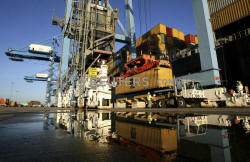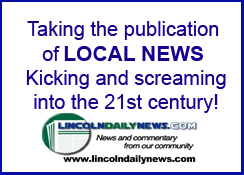U.S. first-quarter GDP growth revised slightly down to
3.1%
 Send a link to a friend
Send a link to a friend
 [May 30, 2019]
WASHINGTON, May 30 (Reuters) - U.S.
economic growth accelerated in the first quarter, the government
confirmed on Thursday, but there are signs that the temporary boost from
exports and inventory accumulation is already fading, with production at
factories slowing. [May 30, 2019]
WASHINGTON, May 30 (Reuters) - U.S.
economic growth accelerated in the first quarter, the government
confirmed on Thursday, but there are signs that the temporary boost from
exports and inventory accumulation is already fading, with production at
factories slowing.
Gross domestic product increased at a 3.1% annualized rate, the
government said in its second reading of first-quarter GDP. That was
slightly down from the 3.2% pace estimated last month.
The economy grew at a 2.2% pace in the October-December period. While
the government trimmed its initial estimate for inventory investment,
export growth was raised. These two volatile components were the key
drivers of the rise in GDP in the first quarter.
There was a small upward revision to consumer spending growth. Business
spending on equipment actually contracted in the last quarter, while the
housing market was weaker than initially thought.
Economists polled by Reuters had expected GDP growth for the first three
months of the year would be trimmed to a 3.1% rate. Excluding trade,
inventories and government spending, the economy grew at a 1.3% rate as
reported last month. That was the slowest since the second quarter of
2013.

The economy will mark 10 years of expansion in July, the longest on
record.
Growth is, however, slowing. Industrial production and orders for
long-lasting manufactured goods declined in April as businesses placed
fewer orders at factories while working off the inventory overhang.
Retail sales were also weak last month and the housing market continues
to struggle.
The moderation in growth largely reflects the fading stimulus from the
Trump administration's hefty tax cuts and spending increases last year.
A trade war between the United States and China is also seen hurting the
economy.
The Atlanta Federal Reserve is forecasting GDP rising at a 1.3% pace in
the second quarter.
The government also reported on Thursday after tax profits without
inventory valuation and capital consumption adjustment, which correspond
to S&P 500 profits, fell at a 0.8% rate or $15.9 billion in the first
quarter after falling at a 1.7% pace or $34.2 billion in the fourth
quarter.
An alternative measure of economic growth, gross domestic income (GDI),
increased at a rate of 1.4% in the first quarter, compared to fourth
quarter's 0.5% pace.
[to top of second column] |

Crews load and unload
consumer products at the Port of New Orleans along the Mississippi
River in New Orleans, Louisiana June 23, 2010. REUTERS/Sean Gardner

The average of GDP and GDI, also referred to as gross domestic output and
considered a better measure of economic activity, increased at a 2.2% rate in
the January-March period, up from a 1.3% growth pace in the fourth quarter.
Export growth in the first quarter was revised up to a 4.8% rate, outpacing an
upgrade to imports. As a result, trade added 0.96 percentage point to GDP rather
than the 1.03 percentage points estimated last month. Trade tensions between the
United States and China have caused wild swings in the trade deficit, with
exporters and importers trying to stay ahead of the tariff fight between the two
economic giants.
The standoff has also had an impact on inventories. Growth in inventories was
revised down to a $125.5 billion rate in the first quarter from the previously
estimated $128.4 billion pace.
Part of the inventory build was because of weak demand, especially in the
automotive sector, which is weighing on production at factories. Inventories
contributed 0.60 percentage point to first-quarter GDP, rather than the 0.65
percentage point reported last month.
Growth in consumer spending, which accounts for more than two-thirds of U.S.
economic activity, was revised up to a 1.3% rate. Consumer spending was
previously reported to have increased at a 1.2% pace in the first quarter.
Business spending on equipment dropped at a 1.0% pace instead of rising at a
0.2% rate. That was the weakest since the first quarter of 2016. Government
investment increased at a 2.5% rate. It was previously reported to have risen at
a 2.4% rate.
(Reporting by Lucia Mutikani; Editing by Andrea Ricci) ((Lucia.Mutikani@thomsonreuters.com;
1 202 898 8315; Reuters Messaging: lucia.mutikani.
thomsonreuters.com@reuters.net))
[© 2019 Thomson Reuters. All rights
reserved.] Copyright 2019 Reuters. All rights reserved. This material may not be published,
broadcast, rewritten or redistributed.
Thompson Reuters is solely responsible for this content.
 |